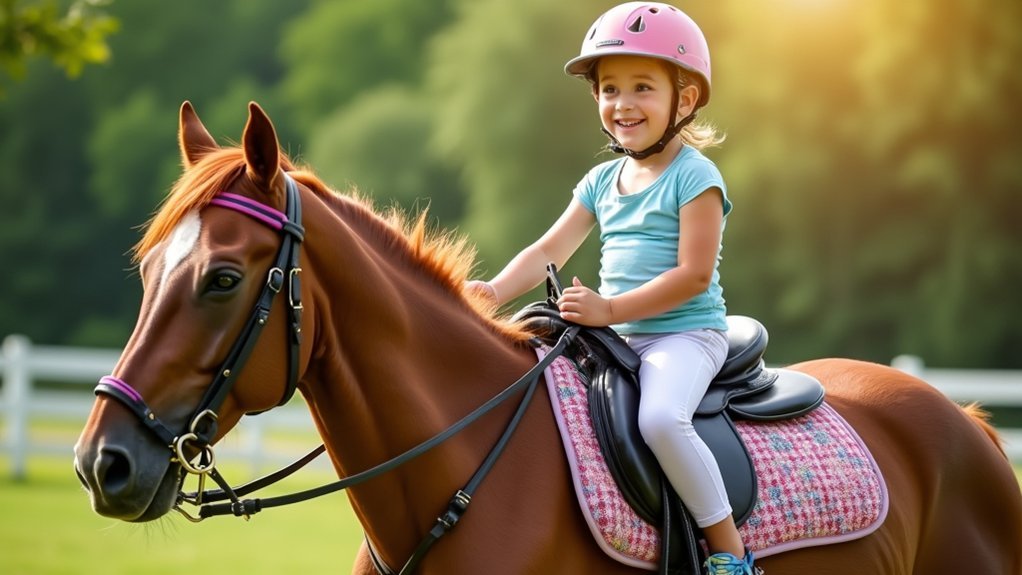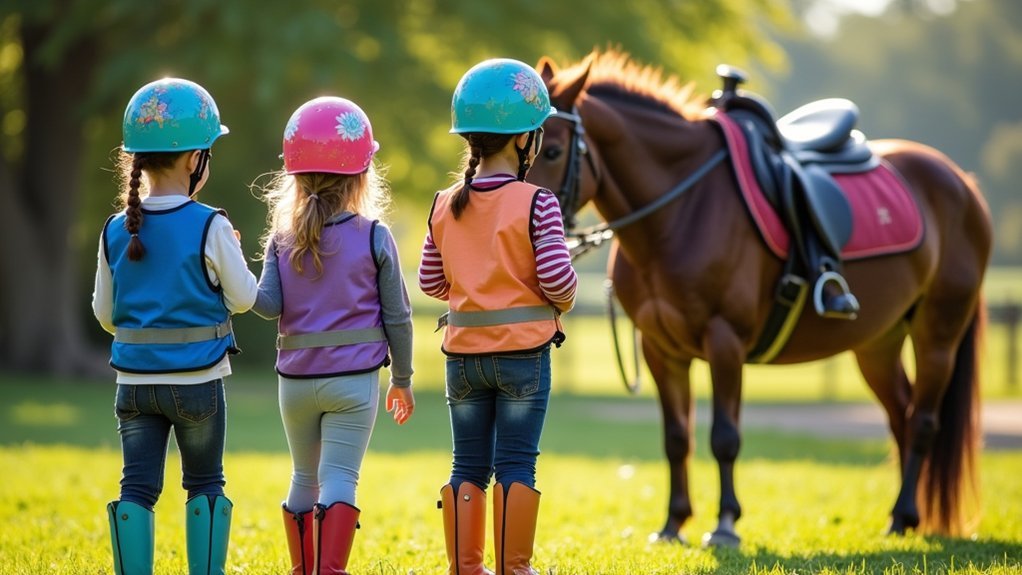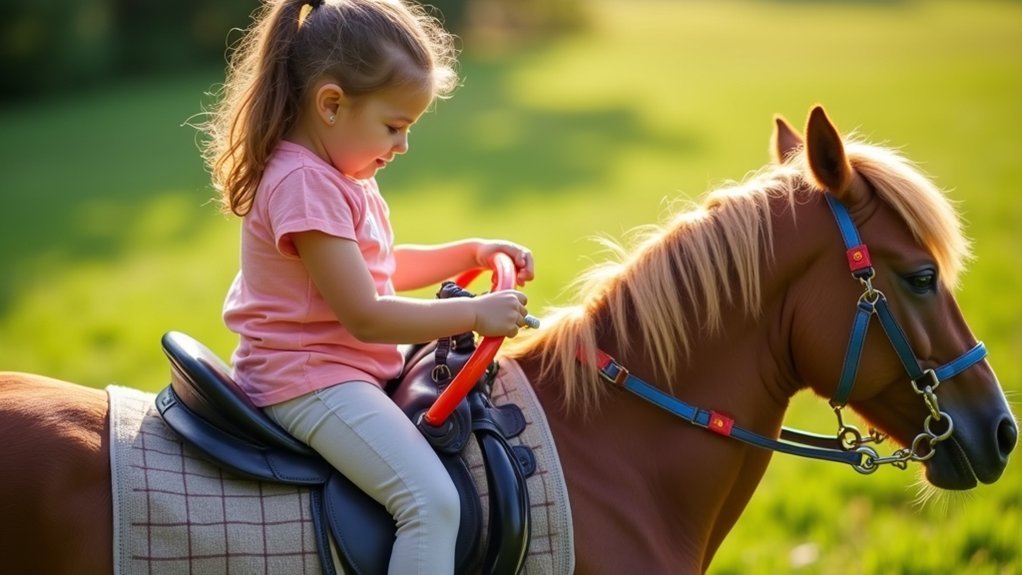Pediatric horse therapy gear includes both safety equipment and adaptive tools that enhance therapeutic outcomes. You’ll need proper helmets, safety vests, and specialized saddles with high backs for stability. Support handles, adaptive stirrups, and gait belts help maintain balance and proper positioning. For non-verbal children, communication tools like picture cards and color-coded indicators enable expression during sessions. The right combination of this equipment transforms equine therapy from challenging to accessible, maximizing your child’s therapeutic benefits.
What Pediatric Horse Therapy Gear Helps Children?

Safety stands at the forefront of equine therapy for children with special needs. When your child participates in therapeutic riding, proper equipment guarantees both their protection and therapeutic success.
Safety helmets are non-negotiable, protecting your child’s head from potential injuries regardless of how gentle the therapy horse may be.
Proper helmets provide crucial protection for all children in equine therapy, even with the gentlest horses.
Adaptive riding saddles provide essential stability for children with physical limitations, with features like high backs and handles that offer additional support during sessions.
Don’t overlook gait belts, which allow therapists to safely maintain your child’s balance and posture while on horseback.
Other specialized equipment like bareback pads and rainbow reins help develop coordination and communication skills, while protective gear such as gloves and chaps prevent scrapes and discomfort during horse interactions.
Understanding Pediatric Hippotherapy Equipment Basics
Pediatric hippotherapy requires specialized safety gear like high-back saddles and gait belts to protect children during therapeutic riding sessions.
You’ll need to familiarize yourself with adaptive equipment essentials including mounting platforms and saddles with handles that accommodate mobility challenges.
These tools, along with sensory integration materials, create a supportive environment where children can safely experience the therapeutic benefits of equine movement.
Safety Gear Fundamentals
Three essential components form the foundation of any pediatric hippotherapy program: properly fitted helmets, protective vests, and specialized adaptive equipment.
Your child’s helmet should be personal for ideal fit and comfort, providing vital head protection during therapy sessions. Safety vests protect the torso, internal organs, and spine from potential injuries during falls or sudden horse movements.
Don’t overlook mouthguards, which safeguard your child’s teeth during riding activities.
Adaptive equipment like high-back saddles and rainbow reins enhance both safety and accessibility, helping your child maintain proper posture and balance throughout therapy.
Professional instructors will guarantee all safety gear is appropriately sized for your child’s specific needs, as proper fitting directly impacts therapy effectiveness.
When all safety measures work together, your child can focus on the therapeutic benefits of hippotherapy.
Adaptive Equipment Essentials
Innovation in adaptive equipment forms the backbone of effective pediatric hippotherapy, enabling children of all abilities to safely experience therapeutic benefits.
When you’re working with a physical therapist during therapeutic horseback riding sessions, specialized gear dramatically improves safety and effectiveness.
Key adaptive equipment includes:
- High-back saddles with handles that provide essential stability while promoting proper posture
- Rainbow reins and gait belts that offer additional support while encouraging independent control
- Mounting platforms and bareback pads that enhance accessibility and sensory integration
Technology has expanded options beyond traditional settings.
The MiraColt and similar horse simulators mimic equine movement patterns in clinical environments, making hippotherapy accessible to children who mightn’t tolerate actual horseback riding.
Your child’s unique needs will determine which adaptive equipment their therapeutic team recommends.
Essential Safety Gear for Child Equine Therapy Sessions

When safety meets therapeutic benefit, equine therapy can transform a child’s life while keeping risks at bay. Every child requires a properly fitted helmet, meeting the same standards used by Olympic equestrians. Safety vests provide essential protection for the torso and internal organs during unexpected movements.
| Safety Gear | Purpose | Benefit |
|---|---|---|
| Helmet | Head protection | Prevents serious injury |
| Safety Vest | Torso protection | Cushions falls |
| Gloves | Hand protection | Improves grip |
| Mouthguard | Dental protection | Prevents tooth injury |
Don’t overlook specialized items like mouthguards for children with bruxism, and properly fitted gloves and chaps to prevent blisters and leg scrapes. Adaptive equipment such as high-back saddles and rainbow reins guarantees your child can participate effectively while addressing their individual needs and maintaining safety standards.
Specialized Saddles and Adaptive Riding Equipment
Specialized saddles with high backs and handles can dramatically improve your child’s stability and confidence during therapeutic riding sessions.
You’ll find that adaptive equipment like rainbow reins enables children with different physical abilities to participate more independently in equine therapy.
Custom therapeutic stirrups, which can be adjusted for leg length and range of motion, will provide your child with the proper foot positioning needed for effective therapeutic benefits.
Adaptive Saddle Benefits
The remarkable design of adaptive saddles transforms the therapeutic riding experience for children with physical disabilities.
You’ll notice these specialized supports feature high backs, padded seats, and adjustable components that accommodate different body sizes and shapes, promoting better posture and comfort during equine therapy sessions.
When your child uses adaptive saddles during therapeutic interventions, they’ll benefit from:
- Improved stability and support tailored to their specific physical needs
- Enhanced safety and confidence while participating in riding activities
- Greater engagement in therapy, leading to better coordination and strength development
Research confirms that children using adaptive equipment show considerably higher participation levels and achieve more positive outcomes.
The proper support allows therapists to implement personalized approaches that maximize each child’s therapeutic benefits while ensuring they enjoy their riding experience.
Therapeutic Stirrup Options
Beyond adaptive saddles, therapeutic stirrups represent a critical component in creating a safe and effective equine therapy environment for your child.
These specialized tools enhance your child’s therapeutic riding experience by accommodating different foot sizes while providing essential safety features.
Adaptive stirrups with quick-release mechanisms guarantee your child remains secure during horseback riding activities but can dismount rapidly if needed. This balance of safety and accessibility is particularly valuable for children with varying physical abilities.
When combined with other adaptive equipment like rainbow reins, these stirrups offer your child greater independence while allowing therapists to maintain necessary control.
The right stirrup design complements mounting platforms and specialized saddles, creating a thorough support system that maximizes the benefits of therapeutic riding while prioritizing your child’s safety and comfort.
Support Handles and Balance-Enhancing Accessories

Stability forms the foundation of effective equine therapy for children with special needs. When your child begins therapeutic riding, support handles provide essential stability, allowing them to build confidence while maintaining proper balance during sessions.
Balance-enhancing accessories can be customized to meet your child’s specific requirements:
- High-back saddles and rainbow reins improve posture and strengthen core muscles as your child navigates various riding experiences.
- Adaptive equipment like specialized saddles with handles and mounting platforms guarantees safe shifts for children with mobility challenges.
- Bareback pads offer closer contact with the horse, intensifying the sensory experience while promoting better coordination.
You’ll find these accessories particularly valuable as your child progresses through therapy, creating a personalized approach that evolves with their growing abilities and changing therapeutic needs.
Sensory Integration Tools for Horseback Therapy
While therapeutic riding builds physical skills, sensory integration tools transform horseback therapy into a thorough experience for children with sensory processing challenges. High-back saddles and rainbow reins provide essential support and security, helping children feel safe as they navigate their therapeutic experience.
Before mounting, groundwork activities help children develop comfort with horses while addressing sensory integration goals. You’ll find specialized equipment like bareback pads and saddles with handles that therapists customize to each child’s unique sensory needs.
The horse’s rhythmic movement mimics natural walking patterns, delivering valuable sensory input that improves balance and coordination.
Throughout sessions, trained volunteers and therapists accompany children, ensuring safety and providing sensory support in a positive environment where adaptive devices enhance rather than hinder progress.
Therapeutic Stirrups and Foot Positioning Systems
Therapeutic stirrups and foot positioning systems serve as critical foundations for successful pediatric equine therapy sessions. These specialized tools provide enhanced stability and proper alignment, helping your child maintain correct posture throughout their riding experience.
Specialized foot tools create the stable foundation every child needs for transformative equine therapy experiences.
Foot positioning systems feature adjustable components that can be customized to meet your child’s unique therapeutic needs.
- Quick-release safety mechanisms protect your child in emergency situations
- Proper foot placement encourages improved balance and coordination during rides
- Specialized designs help reduce muscle tension and promote better posture
You’ll notice therapeutic stirrups make a significant difference in your child’s riding experience, as they create a secure foundation that allows them to focus on other therapeutic aspects of horseback riding.
This enhanced stability often leads to better therapeutic outcomes while keeping safety as the top priority.
Helmet Options for Different Therapeutic Needs
Choosing the right helmet stands as one of the most crucial decisions you’ll make for your child’s equine therapy experience. Safety must remain your top priority, with ASTM/SEI-certified helmets offering the protection your child needs during therapeutic riding sessions.
You’ll find specialized helmets designed specifically for therapeutic programs, featuring lightweight construction and snug fits that accommodate children with various disabilities.
Look for models with adjustable straps and removable liners that can be customized to your child’s specific comfort needs and therapeutic requirements.
Don’t forget to regularly assess your child’s helmet fit as they grow. A properly fitted helmet should sit level on their head without shifting during movement.
When it comes to helmet options, investing in quality protection guarantees your child can focus on the therapeutic benefits of riding without compromising safety.
Trunk Support Devices and Postural Aids
Once your child is properly helmeted, trunk support devices become the next vital component in their therapeutic riding gear. High-back saddles and specialized options with handles provide the stability your child needs to develop proper posture and balance during therapy sessions.
Specialized trunk supports help your child develop proper posture and balance while enhancing their therapeutic riding experience.
Postural aids like gait belts and mounting platforms serve important safety functions:
- They help therapists assist your child in maintaining an upright position.
- They facilitate safe mounting and dismounting from the horse.
- They can be tailored to your child’s specific mobility challenges.
These customized supports guarantee your child can participate actively regardless of their mobility level.
When properly fitted, trunk support devices and postural aids greatly reduce fall risks while enhancing your child’s confidence and security during their riding experience—making therapy both effective and enjoyable.
Communication Tools for Non-Verbal Riders
Communication tools transform the therapeutic riding experience for your non-verbal child through specialized picture communication cards that enable expression of needs and preferences.
Sensory signal systems featuring tactile cues and textured objects help your rider respond to instructions and connect with their horse.
Tech-enhanced riding accessories, including speech-generating devices and digital communication boards, can be mounted to saddles or vests, allowing your child to communicate effectively throughout their therapy session.
Picture Communication Cards
The right communication tools can transform the therapeutic riding experience for non-verbal children. Picture communication cards provide a visual bridge that helps children express their needs, emotions, and preferences during horse therapy sessions.
These customizable visual aids greatly reduce frustration while empowering your child to actively participate in their equestrian experience.
Research shows these cards improve social interactions by giving children with limited verbal skills a reliable method to communicate effectively with horses and instructors.
You’ll find that picture cards can be tailored to your child’s specific therapy goals with images depicting:
- Commands they want to give the horse
- Emotions they’re experiencing during the session
- Activities they’d like to try next
This simple tool fosters independence and engagement, making therapy sessions more productive and enjoyable.
Sensory Signal Systems
When traditional verbal commands aren’t possible, sensory signal systems become essential bridges connecting non-verbal riders with their therapy horses and instructors.
These specialized communication tools incorporate visual, auditory, and tactile signals that allow children to express their needs and commands effectively.
You’ll find these systems often use color-coded indicators or symbolic representations that correspond to specific actions or emotions.
This thoughtful design helps your child communicate clearly with both the horse and therapy team.
Tech-Enhanced Riding Accessories
Modern technology has revolutionized the way non-verbal riders connect during equine therapy sessions, offering unprecedented freedom of expression where traditional methods fall short.
Tech-enhanced riding accessories specifically designed for communication can transform your child’s experience by creating genuine two-way interaction.
Consider these innovative solutions for non-verbal riders:
- AAC tools and tablet applications that allow symbol selection or speech output while mounted
- Adaptive headsets with microphones that enable communication with therapists and handlers throughout the session
- Visual aids and sign language boards integrated into riding equipment for seamless horse-rider interaction
These communication devices bridge essential gaps, helping your child express needs, feelings, and experiences during therapy.
Research confirms these tools markedly improve social skills and emotional well-being, ultimately enhancing therapeutic outcomes for non-verbal riders.
Frequently Asked Questions
How Does Horse Therapy Help Children?
Horse therapy helps you improve your physical strength, coordination, and balance. It also boosts your emotional well-being and self-confidence while enhancing your social skills through meaningful interactions with horses and peers.
Is Horse Therapy Good for an Autistic Child?
Yes, horse therapy’s excellent for your autistic child. You’ll see improvements in their emotional regulation, social skills, physical coordination, and confidence. It provides a calming environment where they’ll develop communication skills through structured, therapeutic interactions.
Do Horses Help Kids With ADHD?
Yes, horses can greatly help your child with ADHD. They’ll benefit from improved focus, better emotional regulation, and reduced anxiety. The structured environment and rhythmic riding promote calmness while fostering responsibility and social skills.
Will Insurance Pay for Equine Therapy?
Your insurance may cover equine therapy if it’s provided by a licensed therapist. Check if it’s included under occupational or physical therapy benefits. You can also use HSAs or FSAs for these expenses.
In Summary
To equip your child for successful hippotherapy, you’ll need to invest in proper safety gear, adaptive saddles, and specialized supports. Don’t overlook essential items like therapeutic stirrups, customized helmets, and postural aids that address specific developmental needs. With the right equipment, you’re not just ensuring safety—you’re maximizing therapy benefits and helping your child build confidence, strength, and communication skills through their equine connection.





Leave a Reply